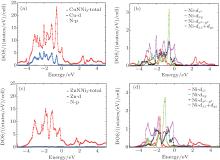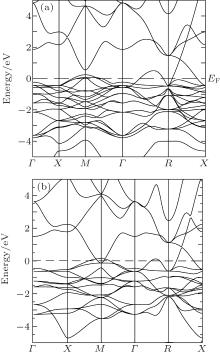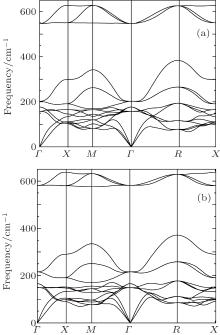†Corresponding author. E-mail: glcjyong@guat.edu.cn
*Project supported by the Scientific Research Fund of Guilin University of Aerospace Technology, China (Grant No. YJ1410).
Very recently, a new Ni-based antiperovskite nitride superconductor CuNNi3 has been successfully synthesized. We investigate the electronic structures, phonon dispersions, and electron–phonon interactions of CuNNi3 and the isostructual ZnNNi3 by first-principles approach. By analyzing the Eliashberg function we obtain the superconducting transition temperature Tc 3.16 K (3.53 K), which is in good agreement with corresponding experimental Tc 3.2 K (3 K) for CuNNi3 (ZnNNi3). They can be verified as conventional phonon-mediated superconductors.
Since MgCNi3 was discovered to be superconducting near 8 K, [1] much attention has been focused on the isostructural cubic antiperovskites, with formula XCNi3 (X is a group II or III element). They are possible candidate with high superconducting transition temperature and other significant technological characteristics. A super-conducting (Tc ∼ 3 K) nitrogen-containing anti-perovskite, which has been successfully prepared by reacting Zn with Ni powders in NH3 gas, [2] is very attractive. In the framework of the rigid-band view, ZnNNi3 anti-perovskite can be considered as a one-electron-doped superconducting MCNi3 (M is divalent cation), in which the Fermi level should be located far from the Ni 3d peak, i.e., in the region of extremely low density of states (DOS), which is not inclined to superconductivity. In addition, as far as we know, ZnNNi3 is the first nitrogen-containing superconducting material in the Ni-based anti-perovskite series. In all known similar structures, namely in superconducting oxide perovskites, superconductivity is based on the electron– hole states of the oxygen atoms occupying 3c− type positions (0, 1/2, 1/2). In CuNNi3, these positions are occupied by Ni atoms; this means that the mechanism of superconductivity probably is radically different. The fact that superconductivity rather than ferromagnetism occurs in compound where much nickel is present is surprising and suggests that CuNNi3 is an unconventional superconductivity. Helal and Islam have studied the elastic and electronic properties of SnNNi3 and CuNNi3, by first-principles approach, [3] and showed that their metallic properties are like those of superconductor ZnNNi3. Mechanical stability and thermal properties of ZnNNi3 under pressure were also studied.[4] Very recently CuNNi3 has been successfully synthesized and exhibits its superconductivity as the second nitride superconductor in the Ni-based antiperovskites with a transition temperature of 3.2 K, and the estimated electron– phonon coupling strength is 0.53, which means weak coupling.[5] There is no literature discussing superconductivity of Cu(Zn)NNi3 from the viewpoint of lattice dynamics and elctron– phonon interaction through theoretical calculation. Using first-principles calculation, we obtain knowledge of electronic and dynamic properties of Cu(Zn)NNi3 to preliminary explore the superconductivity.
The rest of this article is organized as follows. In Section 2 we present all the computational details. In Section 3 we describe the crystal structure, electronic state, crystal vibration, and electron– phonon interaction properties. Some conclusions are drawn from the present study in Section 4.
We calculate both CuNNi3 and ZnNNi3 under the same condition. Electronic properties and lattice dynamics are performed with density functional theory (DFT)[6] and density functional perturbation theory (DFPT) respectively.[7] The full potential WIEN2k package[8] is utilized for calculating the electronic structure with plane wave function expand to RMTKmax equal to 7.0 (Kmax is the magnitude of the largest reciprocal lattice vector and RMT is the smallest in all the muffin-tin sphere radii), muffin-tin radii are automatically determined to be 1.249 Å , 1.275 Å , 0.831 Å , and 0.937 Å for Cu, Zn, N, and Ni atoms respectively.[9, 10] A modified tetrahedron method[11] is adopted for Brillouin zone integration with A 18 × 18 × 18 k-mesh to reach the convergence of total energy. For phonon band structure and electron– phonon coupling calculation, the Quantum ESPRESSO package[12] is applied with plane wave pseudopotential method and generalized gradient approximation of Perdew, Burke and Ernzerhoff (GGA-PBE) for exchange– correlation interaction. Ultrasoft pseudo-potentials[13] are well checked and employed. The energy cutoff of plane-wave basis wavefunction is set to be 544 eV. Full Brillouin zone phonon spectra are obtained from a Fourier interpolation of dynamical matrices calculated on a cubic (4 × 4 × 4) q-point mesh. A 36 × 36 × 36 k-mesh, with a Methfessel– Paxton Gauss smearing of 0.408 eV is taken for double δ function integration for the Eliashberg function calculation (see Subsection 3.4).[14]
The Ni-based Cu(Zn)NNi3 antiperovskite superconductor possesses the cubic space group 
| Table 1. Values of equilibrium lattice parameter (Å ) and transition temperature (K) of ZnNNi3 and CuNNi3. |
Our calculated band structures of CuNNi3 and ZnNNi3 agree fairly well with those in previous work, [3, 9] CuNNi3 exhibits nearly identical band structure with ZnNNi3 except a few differences (Fig. 2). For instance, there is no overlap of conduction band and valence band at M point for CuNNi3. Three bands go across the Fermi energy which contributes most to electron– phonon interaction. The most remarkable feature of the electronic density of states is a sharp van Hove peak less than 500 meV down from fermi energy (Fig. 3) which arises from antibonding bands relating to the Ni d orbitals. They are very narrow due to the linear Ni coordination, two nitrogen atoms become nearest neighbors of Ni, and thus it is expected that Ni 3d and N 2p electrons are strongly hybridized. Main contribution to states near fermi energy comes from Nidxz, dyz and Ni dx2 − dy2 as can be seen from partial density of states (Fig. 3).
 | Fig. 3. Calculated total and projected electron DOSs of CuNNi3 [(a) and (b)] and ZnNNi3 [(c) and (d)]. |
DOS at the Fermi level is dominated by the Ni d-states: it is not large enough to induce magnetic instabilities.[15] However, the DOS is sufficiently large to produce strong electron– phonon coupling. CuNNi3 can be considered as a hole-doped ZnNNi3, DOS of CuNNi3 at EF is higher than ZnNNi3 suggesting that it is favorable for superconductivity.
The phonon spectrum is shown in Fig. 4. There are 15 phonon branches in the full phonon dispersion including three acoustic and twelve optic phonon branches since the unit cell consists of five atoms. Owing to the large differences in mass, the phonon band of Cu(Zn)NNi3 decomposes well into two parts, a low-frequency region with predominant Ni and Cu modes and vibrations of the N atom around 600 cm− 1 due to its small mass (Fig. 4). The stoichiometric compound is dynamically stable in the harmonic approximation since the entire modes exhibit positive frequencies. We can conclude that at our optimized lattice constant Cu(Zn)NNi3 lies at least in its local minimum of energy surface.
Figure 5 shows both the total and atom-projected phonon density of states (PHDOS). The acoustic modes are mainly of Ni characteristic with only a small hybridization of Cu modes. A remarkable feature from the PHDOS of CuNNi3 and ZnNNi3 is the significant mixed characteristic of phonons from different atoms particularly in a region from 150 cm− 1 to 200 cm− 1 which is responsible for the renormalized phonons arising due to the coupling between electrons and phonons.[16] This suggests that Cu(Zn)NNi3 can be viewed as a moderately strong electron– phonon interaction substance, which will be discussed in detail below.
We now discuss the interaction between electrons and phonons. The electron– phonon coupling (EPC) constant λ is usually extracted from the Eliashberg function α 2F(ω ) which describes the averaged coupling strength between the electrons of Fermi energy and the phonons of energy ω . It is used to derive the Tc of a conventional phonon-mediated superconductor as follows:[17– 19]

where ε F is the Fermi energy, N(ε F) is the electronic DOS per atom and per spin at the Fermi level, ω qυ is the phonon frequency indexed with wave vector q and mode number υ . The phonon linewidth γ qυ is given by the Fermi “ golden rule” as follows:

with ε kj being the electron eigenvalue indexed with wave vector k and the band index j, the electron– phonon matrix element 

Both ψ kj and ψ k+ qj′ states have the Fermi energy ε F, η qυ (R, v) is the eigen-vectors of a qυ mode. MR are the nuclei mass. Veff is the one-electron potential due to the phonon distortion. The expression of EPC is also given in terms of the Eliashberg function:

After λ is obtained from

the transition temperature can be calculated from the Allen-Dynes formula as follows:[20, 21]

where ω max is the maximum phonon frequency, μ * is the screened Coulomb pseudopotential parameter with typical value in a range of 0.10– 0.15.
Our calculated Eliashberg function is shown in Fig. 6. The deviation of the shape of α 2F(ω ) from that of PHDOS suggests that phonons with different energies almost make comparable contributions to α 2F(ω ), which suggests isotropical superconductors. They originate from the isotropical crystal structures and d electron distributions. However, the cases of MgB2[22] and graphene[23] are very different: only two narrow peaks emerge in α 2F(ω ), which means that only several phonon modes involved in plane vibration have strong couplings. Comparing Fig. 5 with mode resolved α 2F(ω ) in Fig. 6 (colored lines), at lower energy (between 20 cm− 1 and 180 cm− 1) each mode makes a larger contribution to α 2F(ω ) than the others. At higher energy (above 180 cm− 1) much less phonons are involved in the process of electron scattering. The λ characterizes correction magnitude of several physical parameters due to the electron– phonon coupling[24, 25] such as quasi-particle energy, effective mass, electronic heat capacity, etc. The calculated value of λ is 0.6924, which means that the coupling strength between electrons and phonons in CuNNi3 is strong. As can be seen from Table 1, Tc is 3.16 K when selecting μ * as a typical value of 0.13. The calculated value of Tc agrees excellently with 3.2 K measured in recent experiments.[5] For ZnNNi3, the calculated value of λ is 0.6922 and Tc is 3.53 K, which fits well to experimental critical temperature Tc ∼ 3 K.[2] This further demonstrates that the superconducting behavior of Cu(Zn)NNi3 is described properly by the conventional BCS phonon-mediated mechanism. It is expected that the EPC strength and transition temperature can be enhanced by applying biaxial tensile strain which will significantly soften certain modes.[23]
Using first-principles calculation based on density functional theory, we study the electronic, lattice dynamics, electron– phonon coupling properties of Ni-based antiperovskite nitride superconductor CuNNi3 and ZnNNi3. Phonon dispersion calculation without negative frequency indicates that the optimized structure is in dynamic stability; furthermore α 2F(ω ) is obtained from electron– phonon interaction calculation. The low energy phonons are more involved in the process of scattering of electrons than the high energy phonons. The calculated transition temperatures are 3.16 K and 3.53 K for CuNNi3 and ZnNNi3 respectively, experimental results are 3.2 K and 3 K. This clarifies that the superconductivity is governed by the BCS mechanism. They can be categorized as a conventional phonon-mediated superconductor.
We would like to express our sincere gratitude to associate research fellow Weng Hong-Ming for helpful discussion and Key Laboratory of Condensed Matter Theory and Computaion, Institute of Physics, Chinese Academy of Sciences for supplying computating resources.
| 1 |
|
| 2 |
|
| 3 |
|
| 4 |
|
| 5 |
|
| 6 |
|
| 7 |
|
| 8 |
|
| 9 |
|
| 10 |
|
| 11 |
|
| 12 |
|
| 13 |
|
| 14 |
|
| 15 |
|
| 16 |
|
| 17 |
|
| 18 |
|
| 19 |
|
| 20 |
|
| 21 |
|
| 22 |
|
| 23 |
|
| 24 |
|
| 25 |
|







